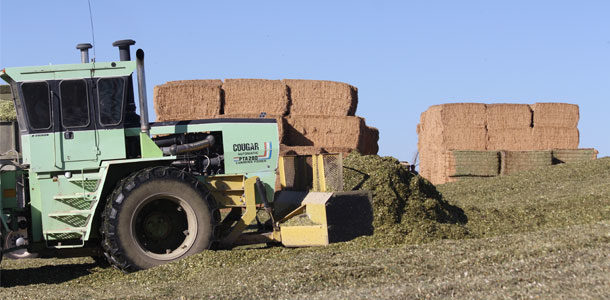Silage storage and feedout dry matter losses (shrink) not only deal a wallop to the wallet, but also negatively affect the nutritional value of the remaining silage. That’s because shrink consumes the most valuable silage nutrients, which must then be replaced with an equal energy source, such as corn grain.
Key management principles for silage storage
Storage and shrink losses begin with plant cell respiration and aerobic microflora utilizing carbohydrate sources (primarily sugar), which produces water, heat and carbon dioxide. These processes will continue until the trapped oxygen in the silage mass is depleted. Proper plant moisture and compaction play important roles in reducing the length of this aerobic phase in the storage structure by reducing silage porosity.
Sufficient moisture
The subsequent anaerobic phase establishes an environment suitable for domination by homofermentative and heterofermentative lactic acid bacteria. These bacteria – which create desirable fermentation – need water to live, grow and produce acid. Sufficient moisture also enables the producer to expel the air from the silo more efficiently. Anaerobic fermentation losses can be reduced by 25 percent or more with the use of homofermentative strains found in a research-proven, reputable silage inoculant.
The maturity of corn silage at harvest has a dramatic impact on the nutritional value of individual hybrids. Increased starch content as the plant matures improves feed quality as harvest approaches. These gains come without reducing fiber digestibility in hybrids with excellent late-season plant health, stalk strength and standability.
Compaction
The person operating the silage-packing device is the critical link to improving density. Poorly packed, low dry matter silages have extended plant cell respiration, which results in an increased loss of digestible nutrients. Trapped air can allow for the growth of aerobic organisms (harmful yeasts and molds), which are detrimental to the ensiling process.
Brian Holmes, University of Wisconsin – Madison, and Professor Emeritus Keith Bolsen, Kansas State University, provide the following advice:
-
Check silage densities, but only if it can be done safely.
- Be prepared to adjust filling and packing procedures.
-
Reduce the forage delivery rate.
- This can be difficult because few producers and silage contractors are inclined to slow the harvest rate.
-
Employ well-trained, experienced people, particularly in the cases of those who operate the push-up/blade tractor or tractors.
- Provide training as needed, and emphasize safety.
-
Increase the rate of forage push up and packing.
- By increasing this in relation to the harvest rate, producers will reach target density.
-
Spread forage consistently.
- Do this continually in thin layers of 6-8 inches during the entire filling and packing operation.
- Increase packing tractor weight.
-
Increase the number of packing tractor passes over all forage layers.
- Caution: Additional tractor passes require more packing time per ton.
-
Consider drive-over piles.
- Silage piles need to be constructed correctly to be cost-effective. All four sides of the pile (two ends, two long sides) need to be well-packed. All four sides need to be on a slope shallower than a 1-foot rise to a 3-foot run so a packing tractor can get up and over the pile. Piles need to be packed lengthwise and crosswise, which is why the large footprint is required.
Management steps to minimize or prevent surface-spoiled silage:
- Two sheets of plastic or one sheet of oxygen barrier film are preferred to one sheet of plastic.
- Overlap sheets that cover forage surfaces by a minimum of 4-6 feet.
- Arrange plastic sheets so runoff water does not come in contact with silage.
- Sheets should reach 6 feet off the forage surfaces around the perimeter of a drive-over pile.
- Put uniform weight on the sheets over the entire surface of a bunker or pile, and double the weight placed on the overlapping sheets. Bias-ply truck sidewall disks, with or without a lacework of holes, are the most common alternative to full-casing tires. Sandbags filled with pea gravel are an effective way to anchor the overlapping sheets, and they provide a heavy, uniform weight at the interface of the sheets and bunker silo wall. A 6- to 12-inch layer of soil or sandbags is an effective way to anchor sheets around the perimeter of piles.
- Prevent damage to the sheets or film during the entire storage period. Mow the area surrounding a bunker or pile, and put up temporary fencing to safeguard against domesticated or wild animals.
- Regular inspection and repair are recommended, because extensive spoilage can develop quickly if air and water penetrate the silage mass.
- For many years, full-casing discarded tires were the standard method to anchor polyethylene sheets on bunkers and piles. However, they are cumbersome and messy, and standing water in full-casing tires can provide a breeding ground for mosquitoes that may carry the West Nile virus. PD

Bill Ramsey
Livestock Information Manager
DuPont Pioneer
PHOTO
Photo by Jenna Hurty.










